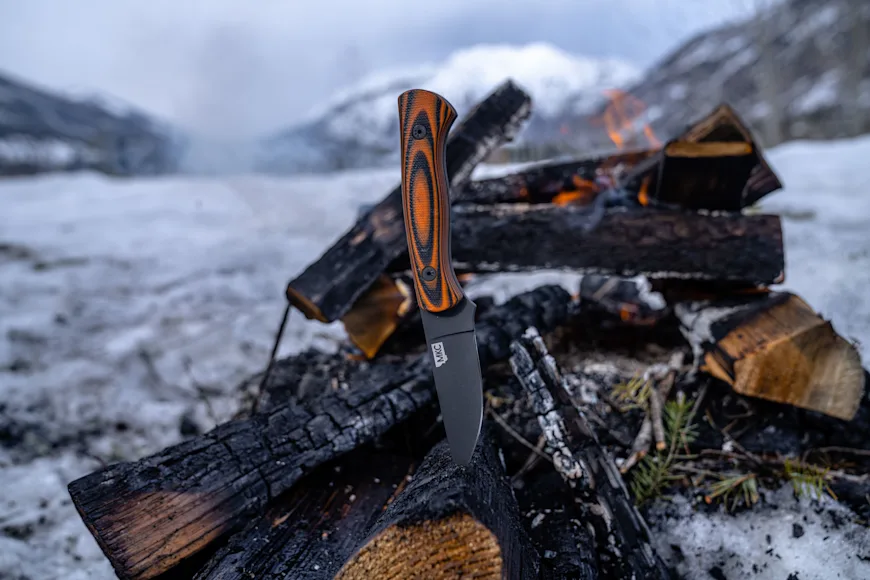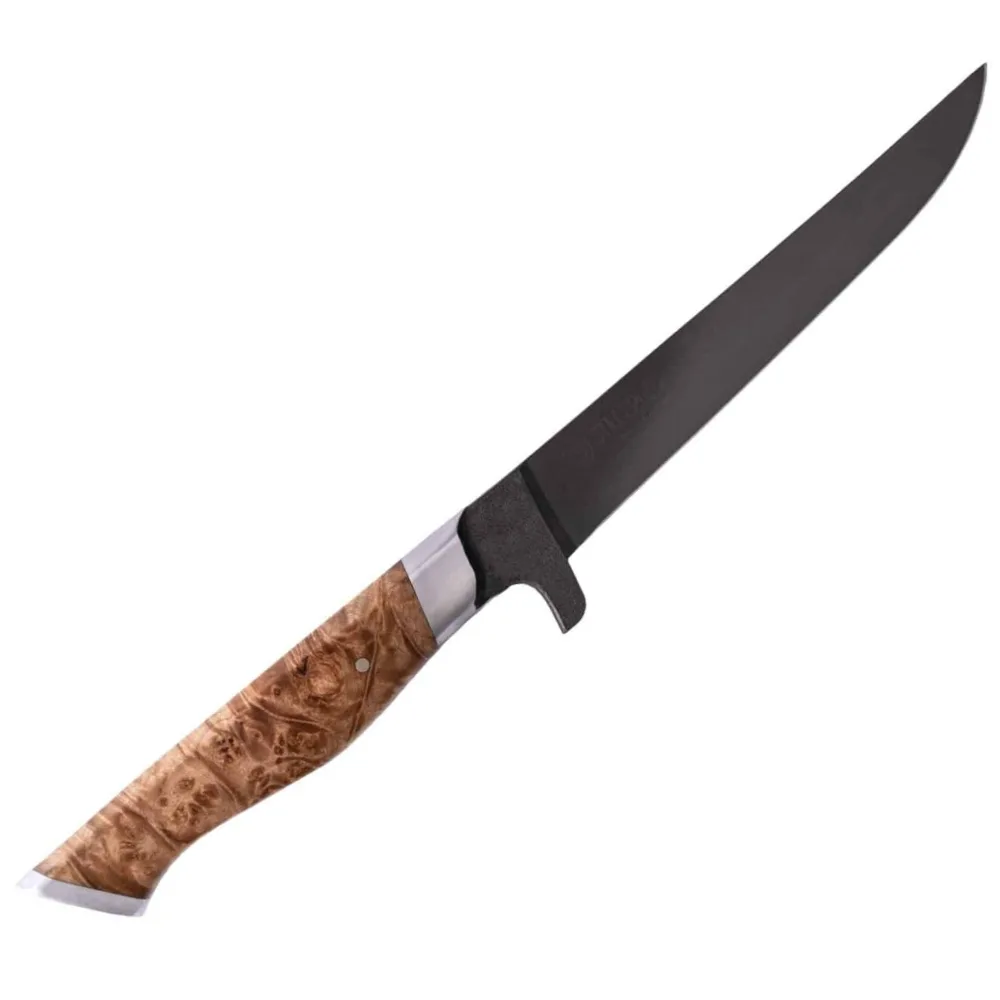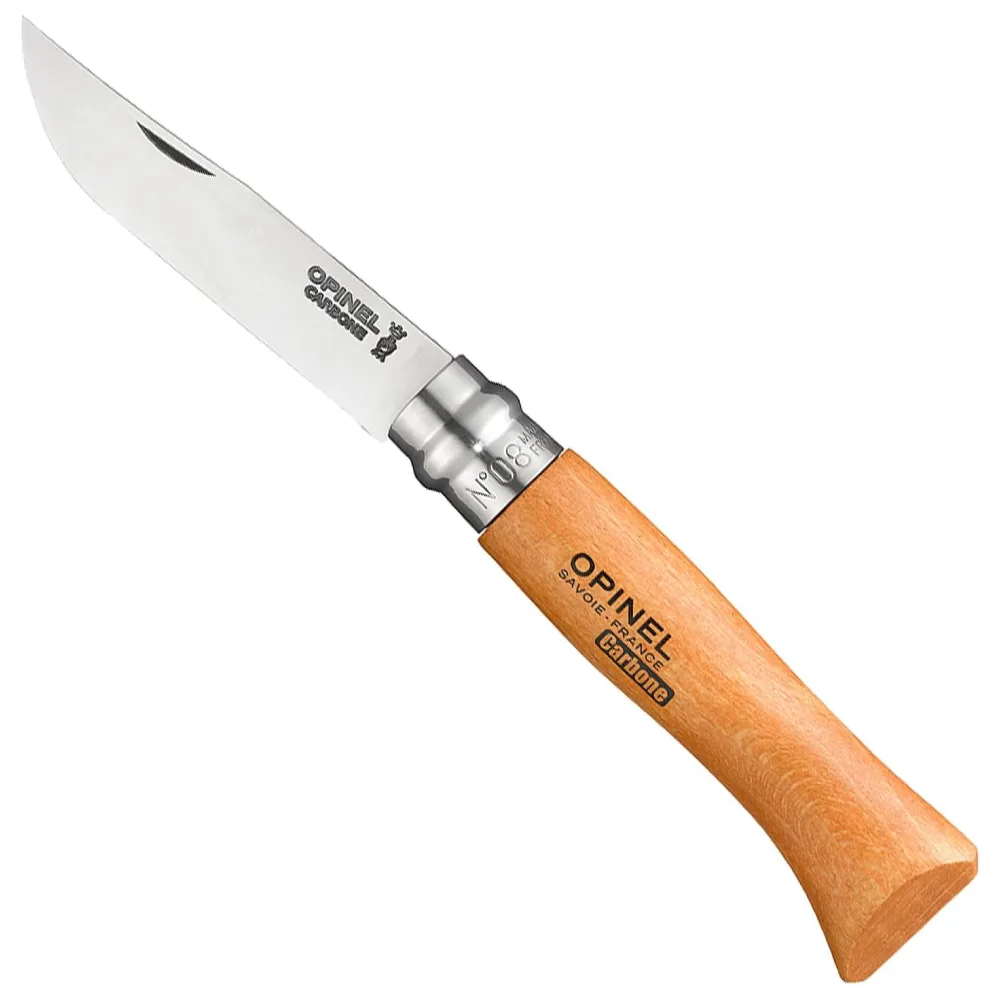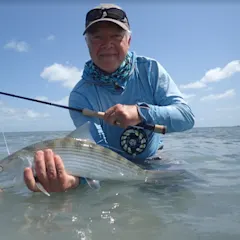We may earn revenue from the products available on this page and participate in affiliate programs. Learn more ›
Before I lost it while climbing out of a canal lock on a long boat trip down the Atlantic coast, my long-term EDC blade—an older version of the Gerber Harsey Air Ranger that’s no longer made—had done it all. With that single blade, I had cleaned deer, ducks, squirrels, and a wild hog; carved fuzz sticks; and removed a rotten toenail in the Canadian backcountry. It still cleaned up nicely enough to cut a wedding cake when the caterer failed to bring her own knife.
But I’ll confess: I will cheat on a knife in a sharp skinny minute. And I encourage you to find and fall in love with a single EDC knife that becomes an extension of your hand—not to mention your pants pocket. But there are simply too many awesome knives out there to tie yourself down to a single blade because no one knife does everything well. My current EDC knife is a Giant Mouse Ace Grand, whose brawny blade isn’t the best at breasting out wood ducks. I could butcher a deer with it, but it wouldn’t be easy. Or pretty. But it handles eight out of 10 cutting duties like a champ. For the other two duties, I have more than a hundred other knives from which to choose. Lucky me.
Speaking of which, here are seven of the best knives to keep in your blade quiver. If you can’t get it done with one of these, you probably shouldn’t be doing it anyway.
Best for Hunting: Montana Knife Company Blackfoot 2.0
Best Bushcraft: Morakniv Garberg
Best Folding: Kershaw Iridium
Best for Waterfowl Hunting: Benchmade Flyway
Best Boning: Steelport Boning Knife
Best for Camp Cooking: Opinel No. 08 Carbon
Best for Hunting: Montana Knife Company Blackfoot 2.0
Specs
Blade length: 3.5 in.
Total length: 7.75 in.
Weight: 3.6 oz
Steel: 52100 ball-bearing steel
Pros
Parkerized steel reduces rust
Gorgeous selection of tough G10 scales
Adjustable Kydex sheath for horizontal or vertical carry
Cons
Expensive
“Just enough” is the Holy Grail of knifemakers when they set out to produce an all-around hunting knife. It’s a juggling act that seems to defy the laws of physics: Just enough of a piercing tip for precise caping cuts on a big game animal, but just enough belly to serve as a skinning blade. Just enough heft for cutting through the hip joint of a 10-pointer, but just enough maneuverability for the tight confines of a rib cage. Just enough toughness to handle being two-handed through an elk’s sternum, but just enough lightness not to ride on your belt like a wet beaver. Montana Knife Company gets it right with the Blackfoot. 2.0.
Let’s start with the blade profile. It’s a just-barely-dropped-point-blade, which is just about perfect. Too many drop-points drop too steeply, which whittles away at what skinny belly they could have. The blade length is just about perfect, too. Long enough to get the job done, and that’s that. The steel choice for this particular model has a high degree of wear resistance, and is tough enough that it’s used to manufacture high-pressure ball bearings. But it does take a wee bit of care. Ergo, the nice subtle Parkerized blade finish. It’s not Ninja-Death-Star overdone black. It’s just enough. If you’d rather have a stainless steel, no sweat. The Blackfoot also comes in Magnacut steel.
And the knife goes overboard where it counts. The tang runs the full length of the handle, but is skeletonized for lighter weight. The G10 handles are tough and hard-wearing, and MFC offers them in tons of colors. The sheath can be worked horizontally or vertically, with a quick attach belt loop.
Best Bushcraft: Morakniv Garberg
Specs
Blade length: 4.2 in.
Blade thickness: 1/8 in.
Total length: 9 in.
Weight: 9.6 oz
Steel: Sandvik 14C28N
Pros
Wicked tough
Several sheath choices
Easy to resharpen
Cons
Handle feels plasticky
Not a great camp kitchen knife
Could use a beefier finger guard
Beat on it, beat with it, bang it, baton it, smash the snot out of it—you won’t find a tougher knife than Morakniv’s Garberg BlackBlade. It’s a full-tang bushcraft and survival blade that isn’t trying to be pretty and couldn’t care less about being cute. It is sharp. It is durable. It holds up to the elements. It will take all the abuse you can throw at it. It’s the knife you’ll want when the going gets holy-crap-we-are-lost-and-it’s-dark.
The design may be a bit Spartan, but the devil is in the components. The steel is high in chromium, so it will resist rolling over or chipping when it is being pounded through wet wood or cutting through handfuls of cattails. The exposed metal pommel turns it into a makeshift hammer. The ground, unpolished spine creates sharp 90-degree angles for maximum spark throwing when using a fire starter. The barrel-shaped handle fills a palm well, and it’s made from polyamide, which is some sort of plastic. It is ugly as a pig in the mud, but that doesn’t matter for the tasks you’ll use it for.
I keep a Garberg in my truck and another on my workbench. More times than not, when something needs to be notched or split or divided into pieces, it’s the knife I reach for. That thick blade and Scandi grind leave a lot to be desired when it comes to cooking dinner. It is simply not a great slicer and dicer and doesn’t pretend to be. It’s not a great skinning knife, either. But when things get real—as in real bad—it’s the blade you’ll want by your side.
Best Folding: Kershaw Iridium
Specs
Blade length: 3.4 inches
Open length: 7.9 inches
Closed length: 4.5 inches
Weight: 3.3 ounces
Blade Steel: D2 high-carbon tool steel
Pros
Spear point blade for general use
Solid locking system
Reversible deep-pocket carry clip
Cons
Somewhat slippery handle
Closing one-handed takes some practice
With a handle of sleek aluminum scales, the Iridium Black is a great lightweight option for EDC. The spear point blade excels at tasks that require piercing, and there’s a generous 3-plus inches of cutting surface to work through thick cordage or a handful of cattails when you’re building a blind. I wouldn’t want to field-dress big game with this knife, only because the untextured aluminum scales got a bit slippery when slimed with sausage fat. But that same slickness helps this blade slip in and out of a pocket very smoothly. The blade locks up with Kershaw’s patented Dura-Lock steel crossbar, so once it’s deployed, you can use this knife with confidence.
D2 steel is a great choice for an all-around blade. It’s easy to resharpen, and pretty tough. The knock against high-carbon steels is their propensity to take on a patina and rust if you don’t take care of them. But Kershaw coated this blade with a black PVD finish to turn away corrosion. In fact, the entire knife is blacked-out, with black oxide handle screws, pocket clip, and back spacer. It’s an elegant knife, one that borders on the tactical.
And the KVT ball bearings in the pivot make this knife open with almost alarming smoothness. You’ll want to play around with the opening and closing mechanisms to get the hang of how easily the Iridium swings into action.
Best for Waterfowl Hunting: Benchmade Flyway
Specs
Blade length: 2.7 inches
Full length: 6.96 inches
Weight: 2.1 ounces
Steel: CPM154
Pros
Abuse-tested G10 handle scales
Lifetime free sharpening from Benchmade
A great camp kitchen paring knife
Cons
A little tricky to sharpen
I get pretty particular when it comes to cleaning ducks. I’ve paid buckets of money to ship waterfowl home from distant hunts, and I don’t want to miss a morsel of meat when cooking, nor do I want to serve up a duck breast hacked all to pieces with an overly large blade. The brand-new Benchmade Flyway seems like it was designed just for me.
The handle is just the right palm-filling length. And the blade geometry is simply perfect for the precise cuts needed when butchering ducks and geese. The perfectly straight spine meets the upswept edge to create a very sharp tip, just what you need when breasting out small ducks such as wood ducks and teal. The knife is made with a full tang, so it punches above its weight in overall strength, but the spine of the tang is made with a series of rolling indentations—sort of like souped-up jimping—to create a super grippy handle. That’s helped with a bit of traditional jimping cut into the mid-spine area, exactly where you would place a fingertip on the back of the blade for increased control.
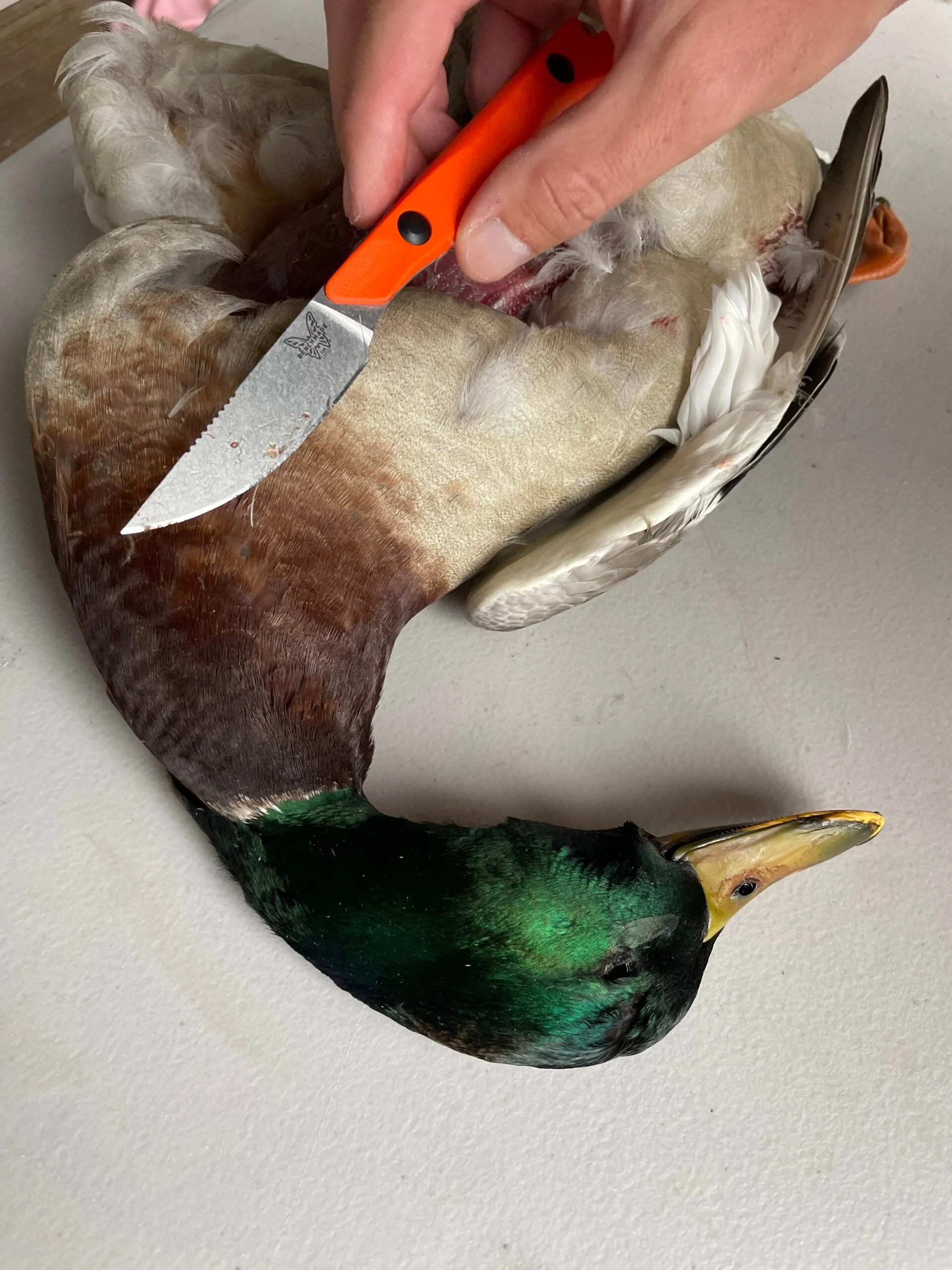
The Flyway comes with Benchmade’s proprietary SelectEdge, which sports a more acute than usual 14-degree bevel for a 28-degree blade angle. Paired with the pretty hard CPM 154 pelletized steel, the Flyway takes a bit of knife knowledge to sharpen properly. But the company offers free lifetime sharpening on SelectEdge blades, so don’t let the unusual edge angle turn you off. This is a well-built, stout little knife, with as much utility in the camp kitchen as just about any other blade you might own.
Best Boning: Steelport Boning Knife
Specs
Blade length: 6 inches
Total length: 12 inches
Weight: 6.7 ounces
Steel: 52100 carbon steel
Pros
Comfortable handle for long hours of use
Tough steel with just enough flex for difficult cuts
Plenty of heft for cutting through joints
Cons
Slightly heavy
Hailing out of Portland, Oregon, a mecca for fine hand-made knives, Steelport Knife Co. is a recent addition to the must-have list of knife makers. A rising star in the culinary world, the company’s 6-inch boning knife is going to wind up in many big-game butcher’s kits. Traditionally forged and produced by hand, the knives are a collaboration between a chef/knifemaker and an engineering Ph.D. They clearly know their knives.
In the hand, this knife seems to invite hard use. The handle is made of gorgeous big-leaf maple burl, locally sourced in the Pacific Northwest, and stabilized with resin. It’s produced with rounded bottom edges and chamfered top edges to reduce fatigue when you’re staring at a monster buck or elk on your butchering table. There’s a slightly longer guard at the bolster for an additional safety boost, and the boning blade carries most of its width all the way to the tip, which is still acute enough to detangle silverskin and make deft cuts through joint ligaments and tendons. And it’s a one-piece blade and tang, with an integral bolster, so this knife is not going to fall apart any generation soon.
Of course, an oak stick is tough and durable, but you don’t sever hip joints with one. That’s where this boning knife really shines: It’s a combination of sharpness and toughness. The blade is differentially heat treated—the edge is a very hard 65HRC, while the spine measures 30HRC to give it a bit of flex and durability. It’s a specialized knife for specialized work. But nothing makes a mound of meat disappear more quickly than a well-tuned boning knife, and this is the one.
Best for Camp Cooking: Opinel No. 08 Carbon
Specs
Blade length: 3.28 inches
Open length: 7.59 inches
Weight: 1.6 ounces
Steel: XC90 Carbon Steel
Pros
Inexpensive
Easy to resharpen
Lightweight
Cons
Wood handle can swell
Requires some maintenance
Could this be the best knife in the world? I wouldn’t argue against it. For some 130 years, this built-in-France classic has engendered a cult following. The high-carbon steel takes a wicked edge and ages with a perfect patina. The slick Virobloc rotating blade lock is genius. The birch handle is sculpted to fill your palm just so, with a slightly bulbous heel that gives it an even greater purchase. It’s inexpensive, iconic, and has a decided flair about it.
The knife comes in 10 sizes, but the No. 8 is the go-to. The only knock against the wood-handled Opinel is that the wood can swell when it gets wet, temporarily making it a little difficult to open the blade. But the swelling goes down once the handle dries, so this is not a deal breaker. You could order this knife in a swell-resistant plastic handle, just like you can order it with a stainless steel blade instead of the traditional carbon steel blade. But by doing so, you will invite scorn and derision from anyone who knows about knives, and certainly from me.
You likely could not cut up a water buffalo with this knife. But if you had a water buffalo backstrap in hand, then you could do literally everything else required: Whittle a feather stick for a cooking fire, chop side-dish veggies, trim away silverskin, peel the accompanying potatoes, cut the steak, carve a marshmallow stick, and pick your teeth, if you wanted to. This is the original 4WD of camp knives, and how they keep it at less than 20 bucks is an international mystery.
How We Tested Knives
It was a tall order: Pick a handful of knives that collectively could handle just about every cutting scenario, from slicing tomatoes at camp to being batoned through kindling in the backcountry to butchering deer at home. I’ve tested and reviewed knives for Field & Stream for years, and have some proven ideas on what steels are best for various cutting tasks, and how grinds and blade profiles affect a knife’s performance.
I also have an at-home and in-the-field protocol that includes some crazy trials. I smear sausage grease on the handles and test for grip and slip. I work blades through inch-thick stacks of cardboard compressed in a shop vice to assess how the edges hold up to the abuse. I incessantly fiddle and play with knives, opening and closing folding blades hundreds of times to assess lock-up and whether a knife performs better with a thumb stud or opening hole.
And I hunt and fish from one end of the country to the other, and often pack a handful of different knives on each assignment for real-world assessment. Each of these knives has had its butt kicked—and its belly, bolsters, spine, and scales. And each of them has come through the gauntlet with high marks. Some are best suited to specific tasks, such as caping a hide or removing meat from bone. Others are great for more general use. But they all deserve a place in your pocket or on your belt.
What To Look For in a Knife
Blade Profile
If you were to trace a knife blade on a piece of paper, the shape you’d draw is the knife’s profile. How a knife performs varies dramatically depending on the blade profile, and it’s a world of tradeoffs. Various profiles will accentuate a sharp point, an arcuate belly, or a dropped point that will help prevent punctured entrails when field dressing a game animal.
Blade Grind
When it comes to a knife’s performance, a blade’s grind is akin to a car’s engine: Do you want hard, boat-towing torque? Or zippy, tire-squealing horsepower? The grind is the shape of the blade when viewed in cross-section. It could be thick or thin. It could taper evenly from the spine to the edge (flat grind), have a concave shape (hollow grind), or have a bevel grind that begins below the midpoint of the blade (Scandinavian grind). Thinner blades generally make better slicers. Thicker blades can hold an edge better and hold up to twisting forces. It’s all about how you plan to use the knife.
Steel Choice
Parsing the growing list of fine knife steels can be a confounding exercise, but choosing the right knife steel has as much to do with a blade’s performance as any other factor. And it goes far beyond deciding if you want a stainless steel or carbon steel blade. Steel recipes are designed to balance or accentuate properties such as ease of sharpness, edge wearability, blade hardness, and overall sharpness, and there isn’t one best choice for all applications. If you find a knife whose profile and grind are appealing, it’s worth taking a few minutes to research the steel to make sure it will perform like you want it to.
Hand Feel
There’s something downright magical about how some knives seem to fit your hand like they were meant to be there. If you love a knife’s shape and heft, but it feels overly large or overly small in your hand, walk on by. If your fingers seem slightly out of whack as they close over a knife’s choil or finger indents, it won’t be a bargain, no matter the price. But when you pick up a knife and note its grind and profile are what you’re after, and it feels like a little piece of King Arthur’s sword in your grip—that’s called “hand feel,” and you can’t put a price on it. Don’t settle for less, regardless of price.
FAQs
Q: What’s the best way to sharpen a knife?
There are tons of knife-sharpening devices out there, from motorized belt sharpeners to angle guides to crock sticks. You’ll be better at using them if you first learn to sharpen a knife by hand with a whetstone. There’s no substitute for getting an innate feel for edge angles and sharpening pressure than by learning the old-fashioned way. Then you’ll be that much better and faster using more modern sharpening aids.
Q: Why is my knife rusting?
If it is a stainless steel knife, it is rusting because you are abusing the hell out of it. So stop. If it is a carbon steel knife, it is turning colors because that’s what carbon steel does. That’s not necessarily rust. You should rinse and dry it carefully after use, oil it lightly, and revel in the patina of blues and browns and every hue in between as the knife takes on a personality all its own. If a carbon steel knife is actually rusting, it is because you are abusing the hell out of it. So stop.
Q: For a serious outdoors person, how many knives are enough?
That’s easy: Just one more will always be plenty.
Final Thoughts
I know old-timers who insist they can do anything, cut anything, slice anything, carve anything, with a Case Barlow slip joint, so why would they ever carry any other knife? And there are others who insist that their insert a famous knife here is the be-all, end-all in the cutlery world.
But there are few more personal decisions you can make as an outdoors person than choosing a knife—or 10. The fact is, you don’t have to spend an arm and a leg for a really great knife, so shop around. Buy one each opening day. Keep the ones that sing to your soul. Trade the others with your buddies.
Try enough knives, and you just may finally settle on the perfect blade. Until the next one comes along.
Why Trust Us
For more than 125 years, Field & Stream has been providing readers with honest and authentic coverage of outdoor gear. Our writers and editors eat, sleep, and breathe the outdoors, and that passion comes through in our product reviews. You can count on F&S to keep you up to date on the best new gear. And when we write about a product—whether it’s a bass lure or a backpack—we cover the good and the bad, so you know exactly w

